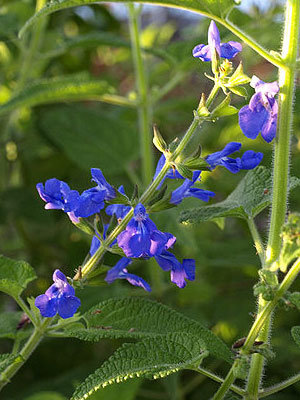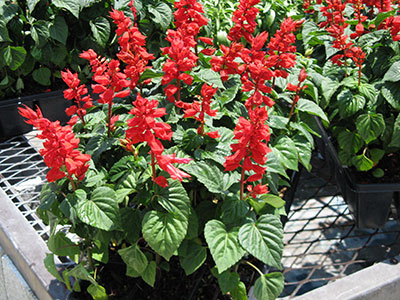Salvias
Salvias are excellent plants for bringing butterflies and hummingbirds to your garden and as a bonus, they have no serious pests. With hundreds of annual and perennial species coming in an array of colors and sizes, there’s a salvia for almost any landscape.

Salvias are at home in mass plantings, borders, and even containers; their loose and natural growth pattern makes them especially well suited to cottage gardens. The slender, tubular blooms of these plants will last for several days in a vase indoors, making them a good choice for a cut-flower garden.
With so many salvias on the market you can easily find the one to fit your landscape conditions and aesthetic.
A good starting place can be deciding what colors you’d like to have in your garden. Salvias come in a rainbow of shades, so there is likely a salvia with the perfect flower color out there for you.
Breeders are releasing new salvias all the time, such as the “Wish” and “Saucy” cultivar lines. Developed in Australia, there are three Wish salvias currently available: Wendy’s Wish™ (vibrant burgundy), Ember’s Wish™ (bright coral), and Love and Wishes™ (deep purple). A portion of the proceeds from the sale of Wish salvias goes to Make-A-Wish® Australia.
Characteristics
Salvias are herbaceous plants, usually with square stems. Flowers are borne in spikes which may be scarlet, purple, pink, blue, white, or yellow.
Salvias offer variety, which is fun but can also be confusing. The height, spread, flower color, flowering season, and cold tolerance will vary depending on the specific salvia. Some species may eve have variable flower colors. For example, the popular and native perennial salvia commonly called scarlet sage or scarlet salvia (Salvia coccinea) can actually have white, pink, or red flowers.
Annual salvias are warm-season performers, but the perennial types will bloom year-round if not killed back by frost or freezes.
While different species of salvia will vary in terms of their height and spread, these plants will generally reach heights between 2–4 feet and can have a spread of anywhere from a foot to 4 feet. Their fast growth will quickly provide your garden with color — and ideally, pollinators.
Planting and Care
Salvias are quite versatile in the landscape and most perform best in full to partial sun, although flowering will be reduced in part shade. The amount of sunlight your plants receive may also influence which flower colors will do best in your landscape. For example, annual salvias with lighter-colored flowers can be burned by the high midday sun in summer, and would do better in an area where they will receive some protection. Darker colors will be more resistant to sunburn.

Salvias will thrive in well-drained soils and are considered relatively drought tolerant. When planting, place transplants 24-36 inches apart for optimum growth. To plant a potted salvia, water your plant before taking it out of the container. Dig a hole that is two times the width of the container. Backfill the hole and plant your salvia one inch above the soil level. Add water and more soil to your newly planted salvia as necessary. You can mulch around your plant to help conserve water and keep weeds down. Additionally, salvia will do best with an application of a balanced, slow-release fertilizer each spring.
To maintain a neat-looking landscape, lightly prune salvia during the flowering season. Cut it back when the foliage begins to die or after damage from a freeze. Some salvias develop woody lower stems with age; feel free to prune this.
Salvia often self-propagates, so you might find seedlings you can use in other parts of your landscape.
For more information on growing salvia in your landscape, contact your county Extension office.
Also on Gardening Solutions
- Add a Thrilling Porch Planter for Fall
- Blue Flowers
- Cut Flower Gardens
- Gardening for Fall Color
- Hummingbird Gardens
- Scarlet Salvia
- Summer Bedding Plants
